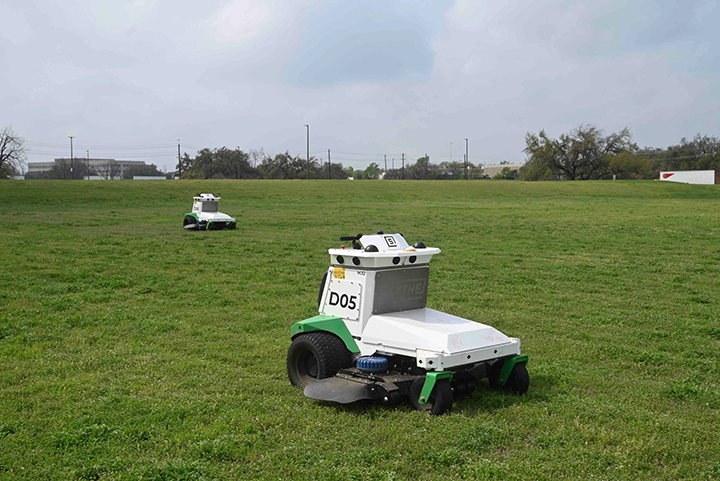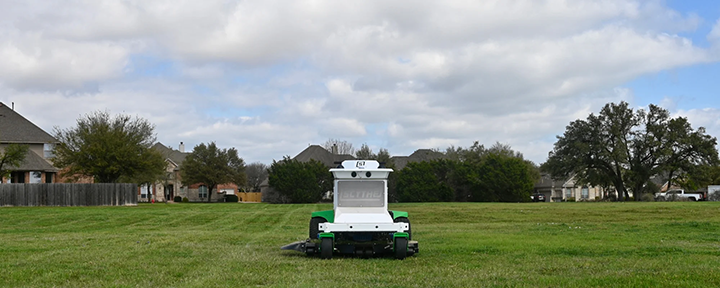The 2023 landscape season is officially underway! A handful of Scythe partners in Texas and Florida recently began mowing with M.52. Here are a few things they did to successfully onboard M.52.
 Top 5 Tips for Rolling Out Robots
Top 5 Tips for Rolling Out Robots

Case Study from | Scythe
1. Pick the right people
When picking the crew members to partner with your first robots, your inclination might be to just find the most tech-savvy people on your team. But knowing the trendiest apps and having the latest gadgets are by no means required to successfully use M.52. We’ve found that adaptability and a willingness to try new things are proving more important than a technological background.
With its familiar stand-on design and intuitive controls, it doesn’t take long for crew members to learn how to mow with M.52. Most pick it up over the course of their first morning with the machine. But it’s the crew members who are willing to try new workflows, experiment how to best implement the technology at the property level, and work through some trial-and-error that have been the most productive with M.52. Those with a “this is the way it’s always been done” mentality will be the most resistant, because robotic mowing hasn’t been done before (until now).
2. Find strong property fit
Some properties are better for initial implementation than others. As we deploy robots to our partners’ operations, we help them figure out where M.52 can create the most impact. The best types of properties to first deploy M.52 tend to have:
Larger, unbroken areas of turf
Think corporate campuses or sports fields over parking lot islands. Typically anything you’d mow with a 48”-104” mower that’s not separated by sidewalks or curbs. This allows M.52 to continue mowing uninterrupted, which leaves your crew uninterrupted as they tackle other tasks nearby.
Regular mowing schedules
The more it mows a property, the more M.52 learns about it. Consistently and frequently mowing the same spots will help the mower perform better over time. It will also help your crew optimize their workflows on site, adjusting week over week as they learn how best to work alongside the machines.
Minimal foot traffic
As M.52 mows on its own, it stops for people and pets. But a bustling plaza or a popular dog park means the mower will be stopping frequently, taking longer to complete the task. Prioritize open areas for autonomous mowing and consider servicing busy areas at off hours.

3. Maximize productivity
M.52 takes care of the mowing, which frees your crew up to perform other services on site. Think detail work, weeding, clean up and more. Multiply the productivity of your crew by picking the properties where they have more to do than mow.
Remember that M.52 can also be used manually. While one unit is finishing a large perimeter, a team member can co-mow with M.52 by jumping on another unit that’s already done to knock out the tricky areas that make more sense to mow manually, like parking lot islands and skinny strips of grass, or others that might be faster manually than in autonomy. This helps ensure no time is wasted.
And if crews get all the detail work done while M.52 is still mowing, leverage that found time! One idea: have crew members walk the property to identify upsell opportunities – like broken sprinkler heads or areas of turf that could use treatment – and flag them for the account team.
4. Make space for change
Your operation runs like a fine-tuned machine. But incorporating new tools – like robotics – takes some flexibility. New workflows might need to be established to make the most of M.52. Or maybe you’ll need to reassess your property allocations per truck route to maximize autonomous mowing. Be open to figuring out which changes will make your teams even more efficient.
Some seasons will have more space for change than others. Training on and implementing M.52 early in the year proved productive for several Scythe partners once springtime hit. They were able to get their team members onboarded, properties prepped, and workflows organized before the grass really started growing.
5. Get power in place
M.52 is all-electric and needs to be charged overnight, so getting your electrical infrastructure ready before deployments is critical. There are many variables influencing what you’ll need to do to prepare – including how much power you’ll need over all and the existing capacity your facility has now – but we are working closely with our partners to help get everything in place as we roll out M.52. We’ll be sharing much more on electrification in the coming months, so stay tuned!

Each of these topics could be a blog post of their own – and they will be soon! This is the first post in the new Get Ready For Robots blog series that will focus on preparing your operations for M.52 deployments.
Stay tuned for more on the topics of training your people, preparing your properties, and upgrading your infrastructure so that your robots can hit the grass rolling.
The content & opinions in this article are the author’s and do not necessarily represent the views of AgriTechTomorrow
Comments (0)
This post does not have any comments. Be the first to leave a comment below.
Featured Product

